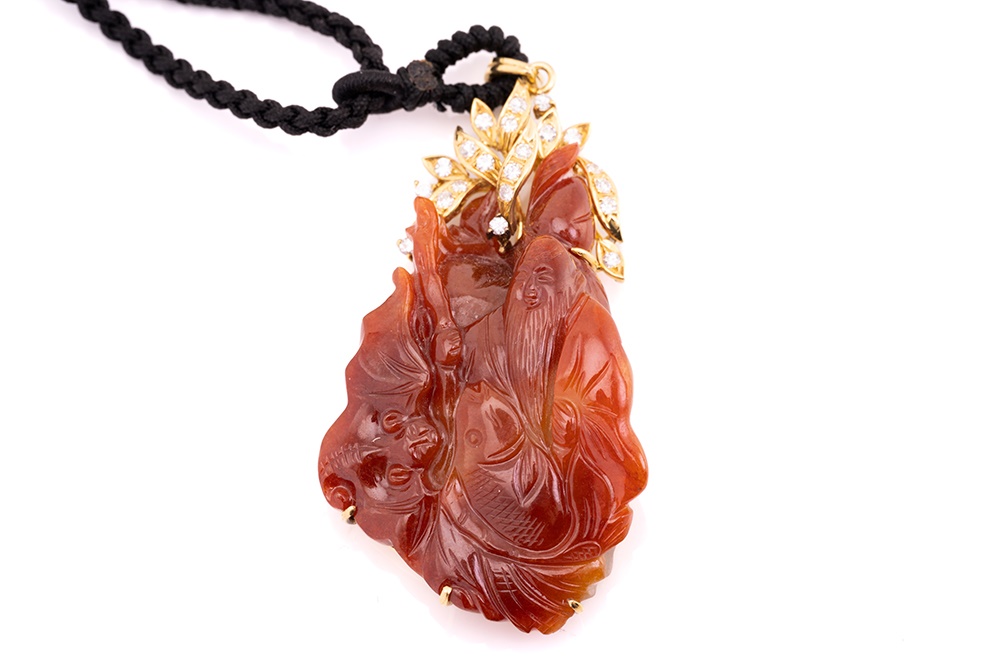Is Chinese Jade Valuable?
Jade has long been revered as a precious gemstone prized for its beauty and durability
01/07/2024
Jadeite has grown in popularity since its discovery in Burma in the 18th Century. In Chinese culture jade is said to protect its wearer, provide good health and knowledge. It was in the mid-19th century that French mineralogist Alexis Damour established a differentiation between jadeite jade and nephrite jade.
In order to understand the value of jade, one must first understand the distinction between the two gems. Jade encompasses both jadeite and nephrite. Whilst nephrite is more widely available, jadeite deposits are found in limited locations such as Myanmar, Russia, Japan and is softer than nephrite. Jadeite is more translucent and can be polished to a higher lustre than nephrite, which is often used for ornaments as opposed to jewellery, such as this large Chinese carved celadon jade Rhyton, possibly late Qing dynasty which sold at Dawsons in 2021 for £32,000.
A large Chinese carved celadon jade Rhyton
The key factors that drive the value of jadeite are colour, transparency and texture. As with every gem, size, carat weight and cut will impact the price such as a round brilliant-cut diamond D, Flawless will be more desirable and therefore more valuable than a marquise-cut diamond with the same colour and clarity.
Jadeite comes in a wide range of colours, the most commonly thought of and most expensive being green, referred to as “Imperial Green”. Other colours include orange, lavender, black, white and red such as the below carved Shoulao, God of Longevity, which Dawsons sold in 2023 for £650.
A carved red jadeite and diamond pendant on a braided cord
These colours can all reach high values when they are clear of any brown or yellow tint. The less tinted the higher the price.
The most desirable green jadeite is clear, absent of any other colour, vivid and semi-transparent and can command millions of dollars.
Some of the factors which can impact the price include the distribution and evenness of the colour. Whatever the colour jadeite, the more uniformity the more valuable. Eye-visible variations such as mottling or moss-in-snow are unfavourable to jadeite’s value.
Texture is also an important element. Fine texture rather than coarse grain is preferrable. The quality of the grain as such will drive the quality of the lustre once polished. The higher the lustre, the more valuable the item.
All these elements were considered when Cartier created the most valuable jadeite jewel to ever have been sold at auction. The below single-strand jadeite bead necklace sold at Sotheby’s in 2014 for HK$214.04 million. It remains the world record for a jadeite jewel sold at auction.
A single-strand jadeite bead necklace sold at Sotheby’s in 2014 for HK$214.04 million
Just like other gemstones, jadeite can be enhanced to improve colour and appearance. And given the high prices that jadeite can reach it is not surprising to understand why enhancements are more and more common. These treatments can include acid treatment to remove any staining (usually brown), or polymer impregnated and dye. It is therefore imperative to request certification from a reputable laboratory when faced with either a high-priced item of jadeite or when assessing the quality of said jadeite.
Read More
Are you considering selling any Chinese Jade?
With a global audience of over 10 million active bidders, Dawsons can secure the highest prices.
Get in touch with an expert Valuer for confidential sales advice, we would be delighted to help you:

